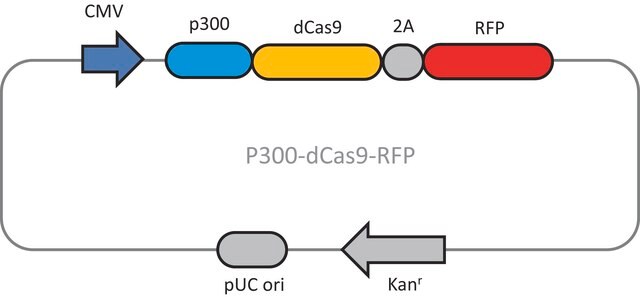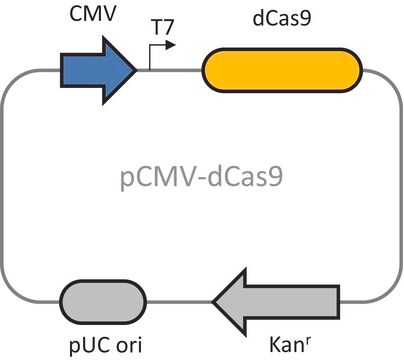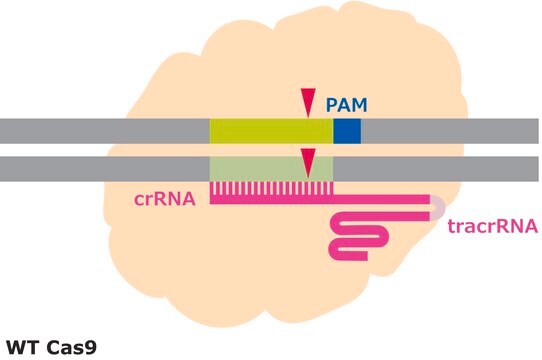DCAS9P300
Sigma CRISPR dCas9-p300 Activator Expression Plasmid
About This Item
Polecane produkty
rekombinowane
expressed in E. coli
Poziom jakości
opakowanie
vial of 50 μL
stężenie
20 ng/μL in TE buffer; DNA (1μg of plasmid DNA)
Zastosowanie
CRISPR
Warunki transportu
dry ice
temp. przechowywania
−20°C
Powiązane kategorie
Opis ogólny
Zastosowanie
- Functional Genomics/Target ValidationEpigenetic Modification
- Transcriptional Activation
Cechy i korzyści
- The Sigma CRISPR dCas9p300 plasmid co-expresses p300-HAT and GFP, to easily monitor delivery and expression in your target cell type (figure 1)gRNAs can successfully direct nuclease-deficient Cas9 (dCas9) fused to p300 HAT catalytic domain to increase levels of histone acetylation and endogenous gene expressionThe dCas9-p300 histone acetylation approach represents a distinct mechanism of action relative to dCas9-VP64 or other similar gene activation motifs
Komponenty
Powiązanie
Click here for more information on dcas9-p300 Gene Activator Expression Plasmid.
Inne uwagi
Kod klasy składowania
10 - Combustible liquids
Klasa zagrożenia wodnego (WGK)
nwg
Temperatura zapłonu (°F)
Not applicable
Temperatura zapłonu (°C)
Not applicable
Wybierz jedną z najnowszych wersji:
Certyfikaty analizy (CoA)
Nie widzisz odpowiedniej wersji?
Jeśli potrzebujesz konkretnej wersji, możesz wyszukać konkretny certyfikat według numeru partii lub serii.
Masz już ten produkt?
Dokumenty związane z niedawno zakupionymi produktami zostały zamieszczone w Bibliotece dokumentów.
Klienci oglądali również te produkty
Produkty
Sigma has developed a gene activation system based on a fusion of dCas9 to the catalytic histone acetyltransferase (HAT) core domain of the human E1A-associated protein p300.
Sigma opracowała system aktywacji genów oparty na fuzji dCas9 z katalityczną domeną rdzenia acetylotransferazy histonowej (HAT) ludzkiego białka p300 związanego z E1A.
Powiązane treści
Sigma-Aldrich® Advanced Genomics jest wiodącym dostawcą technologii edycji i wyciszania genów, w tym CRISPR, Cas9, syntetycznego RNA prowadzącego (sgRNA) i Zinc Finger Nuclease (ZFN).
Sigma-Aldrich® Advanced Genomics is the leading provider of gene editing and silencing technologies including CRISPR, Cas9, synthetic guide RNA (sgRNA), and Zinc Finger Nuclease (ZFN).
Sigma-Aldrich® Advanced Genomics jest wiodącym dostawcą technologii edycji i wyciszania genów, w tym CRISPR, Cas9, syntetycznego RNA prowadzącego (sgRNA) i Zinc Finger Nuclease (ZFN).
Nasz zespół naukowców ma doświadczenie we wszystkich obszarach badań, w tym w naukach przyrodniczych, materiałoznawstwie, syntezie chemicznej, chromatografii, analityce i wielu innych dziedzinach.
Skontaktuj się z zespołem ds. pomocy technicznej














